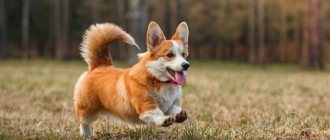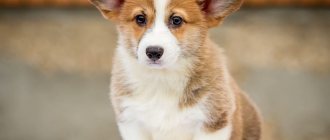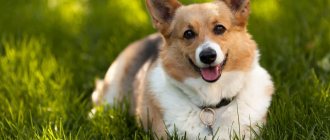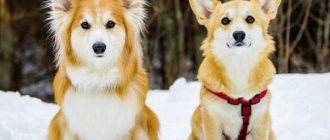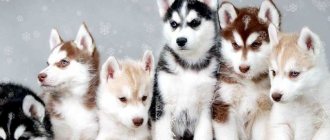Corgis are susceptible to genetic diseases that can appear at absolutely any age. One of the main reasons is the inaction of owners, which leads to neglected cases. It is important to identify the disease in the early stages, because most ailments are most effectively treated only at the very beginning. If the animal’s problems have been ignored for a long time, then it is most likely that the disease has become chronic and cannot be avoided without surgical intervention. Also, an advanced form of any pathology is fraught with serious complications and even the death of the pet.
About the breed
According to a beautiful fairy tale legend, corgis are the helpers of elves and fairies who moved around the world on these dogs. That is why many representatives of the breed have white spots on their backs, reminiscent of the outline of a saddle and harness. They were presented to people like a magical gift. And they quickly found a use for hardy, smart and obedient dogs.
Archaeological excavations in Wales have uncovered the remains of corgi-like animals dating back to the 10th century AD. The name of the breed itself translates as Welsh Dwarf Dog. It is believed that the ancestors of the Welsh Corgi were the Swedish Vallhund and the Icelandic dog. The first representatives of the breed were brought to Britain by the Vikings. Strong and small dogs began to successfully cope with herding work. At the same time, they grazed not only sheep, but also cattle. Their low stature and mobility allowed them to run under large animals, push them in the right direction and dodge their hooves. Surprisingly, they coped with this work absolutely independently; at a signal, they took the cattle out into the fields, monitored them, protected them from wolves, and drove them back in the evening. Later they became shepherds for chickens, geese and ducks, preventing them from wandering off. Welsh Corgis were highly valued. In the 10th century, the monarch even issued a decree according to which compensation in the form of an ox was given for the accidental death of a given dog. While the noblest breeds were not worth even a ram.
Gradually, the breed began to develop in two directions. The result was the Pembroke Welsh Corgi and the Cardigan Welsh Corgi. The names come from the counties of Wales, separated by a mountain range. This did not allow the subspecies to interbreed, which led to an increase in their differences and the consolidation of characteristics. It is believed that the formation of the Pembroke was influenced by Spitz breeds, and the Cardigan breed was influenced by Dachshund breeds.
The breed appeared at official exhibitions for the first time only in 1925. It was then that the English Corgi Lovers Club appeared. And the official recognition of the two subspecies as independent breeds by the American Kennel Club occurred in 1934.
In 1933, King George IV of England gave the puppy Dookie to his daughter Elizabeth. Since then, her faithful Welsh Corgis have always been next to the Queen. Thanks to this, the breed has become widely popular both in England and throughout the world.
Photo
The Welsh Corgi, the photo of which is presented above, is a dog that radiates positivity and good mood. If it is in the house, the owner and all family members will forget about boredom.
Interesting facts about the breed:
Queen Elizabeth II of England is the most famous lover of the Welsh Corgi breed. Her first dog, named Susan, was given to her when she came of age by her father, George VI. The queen had 30 dogs of this breed, all of them descendants of Susan.
Welsh Corgis shed a lot. In spring and autumn, shedding continues for up to 1-2 months, and dogs can cover everything around with hair. The only salvation is daily and thorough combing.
There is an unconventional explanation for the origin of the breed. According to myths, Welsh Corgis were given to humanity by fairies, who used them as mounts. And the marks on the dogs’ backs are nothing more than marks from a magic saddle.
Based on the Welsh Corgi, a new breed of Dorgi was created. This happened as a result of crossing a corgi and a dachshund.
Description of the breed
The Welsh Corgi is a squat dog with a strong build and an elongated body. At first glance, the Pembroke and Cardigan varieties may seem the same, but in fact, many striking differences can be identified. Each breed should be considered separately.
Pembroke Welsh Corgi
The height of an adult dog at the withers is 25-30 cm, weight 10-13 kg. The breed has a fox-shaped head with a “smiling” pointed muzzle. The smile emerges thanks to the dark contour coloring of the mouth. The transition from forehead to muzzle is moderately pronounced. The skull is flat and wide. The nose is black. The ears are erect, medium-sized, pointed. The eyes are medium-sized, round, brown, matching the color of the main color.
The neck is proportional to the body, moderately long, and proudly raised. The back is straight and strong. The tail is short. Previously, it was always docked, but now you can find dogs with a longer tail. And in some countries cupping has been completely banned. If the tail is long, then it is located in line with the body and does not curl towards the back. The coat is straight, shiny, silky with a dense dense undercoat. Slightly longer than cardigans.
The body is elongated and stocky. The limbs are short, straight, and the bone structure is massive. The paws are powerful, oval in shape, with tightly knit toes and thick pads.
The most common colors of the Pembroke Welsh Corgi are red and white, sable, fawn or black and tan. There are black-headed and red-headed representatives of the breed. The Pembroke has lighter hair on the ears and head than on the rest of the body. There is a white collar on the neck, and light spots on the head, paws and belly.
Welsh Corgi Cardigan
Cardigan Welsh Corgi dogs are larger. Height at the withers is usually 30 cm, weight is 14-15 kg, and sometimes reaches 17 kg. The forehead is dome-shaped, the transition from the forehead to the muzzle is clearly expressed. The eyes are deepened. The tail is long, fluffy, drooping downwards. The ears are large and rounded. Compared to the first variety, cardigans are more “eared”. The paws are slightly longer than those of the Pembroke. The wool is dense, two-layer. On top there is a hard coat of medium length, the undercoat is short and soft.
The Cardigan Welsh Corgi can be either brindle (brindle) or gray with black spots (blue merle). The color lines are less neat than those of the Pembroke. The predominance of white wool in color is unacceptable.
You might be interested in the rules for transporting dogs on trains.
Buy a Pembroke Welsh Corgi: tips and tricks
Before you decide on choosing a puppy, you need to learn some information that will not allow you to make a mistake when choosing a puppy. These days, it is noted that a long-haired version of the Pembroke Welsh Corgi called the Fluffy is appearing on the market.
Fluffies are distinguished by the fact that they have a beautiful appearance and are very funny, although they require significant care. As a rule, such puppies are discarded during the breeding process because they do not meet the standard requirements. As for our domestic breeders, many of them, in pursuit of profit, take the path of deception and present the animal as valuable and quite rare, almost unique.
What to look for when purchasing
If you adhere to simple but important rules, then choosing a healthy Pembroke Welsh Corgi puppy is not a problem. For example:
- If you take a puppy from a private breeder, then there is a high probability that the puppy will not meet breed standards. In this case, it is better to contact a nursery that has a good reputation.
- When choosing a puppy, it would be a good idea to inquire about the conditions of detention and the food that the puppy eats.
- When purchasing, information must be provided not only about the puppy’s pedigree, but also about its parents.
- Each puppy must have all the necessary documents including a veterinary card.
If a puppy is inexpensive, then this is a bad factor that should definitely alert the buyer, although many people tend to save money. As a rule, puppies of this dog breed are classified as expensive, since there are some difficulties during breeding.
How to choose the right Pembroke Welsh Corgi puppy
How much do puppies of this breed cost?
Puppies of this breed in the capital and in large cities cost on average from 40 to 60 thousand rubles. In any case, you should focus on the following information regarding average prices for puppies:
- PET class puppies cost an average of 20-25 thousand rubles.
- Puppies of the "BRID" class can be bought for 30-40 thousand rubles.
- Puppies of the "SHOW" class are sold at a price of no less than 45 thousand rubles.
Before purchasing a puppy, you need to take care of allocating a place for it, as well as purchasing all the necessary accessories. It is very important that the puppy is socialized as early as possible.
Pet character and temperament
Welsh Corgi dogs belong to the miniature shepherd family. And this is reflected in the character. Representatives of the breed are smart, courageous and efficient.
If we talk about the differences in behavior between Pembrokes and Cardigans, the latter are more balanced, noble, calm, and their manners command respect. Pembrokes are characterized by greater impulsiveness and activity; they are more optimistic and playful dogs. Regardless of breed, Welsh Corgis are kind, patient and obedient.
They get along well with other animals, even cats and rodents. They are not characterized by conflict. They treat strangers with distrust, but quickly become sympathetic. These are excellent pets if the family has a small child. Corgis love games and enjoy entertaining family members. A powerful physique allows you to not be afraid of accidental injuries from the child. They show genuine love and devotion not only to the owner, but also to the entire family.
The Welsh Corgi is one of the few breeds with an innate sense of humor. They love fun and they like to entertain the viewer. The breed is very sensitive to changes in the owner’s mood, and has a well-developed sense of tact. At an unnecessary moment, it will not intrude or distract you from your work, but if the pet is called to play, it will immediately become active and ready for an energetic pastime.
During games, they can bite the heels and direct the movements, since they are accustomed to herding everything that moves into the group. To prevent this from happening, it is important to train your pet from an early age. Early socialization and adequate training will allow you to get rid of bad habits and raise a patient and obedient pet. In addition, communication with new people and animals increases the dog’s resistance to stress and its immunity.
Training should begin with simple tasks, gradually adding more complex ones. For a Welsh Corgi, 3-4 repetitions are enough to understand and remember the command. Some stubbornness and dominance of the breed should not interfere with training. The owner’s persistence and rigor will quickly give the desired result. If you don’t start training in time, the dog can grow up willful, they are easily spoiled, and Welsh Corgis know how to use their charm and attractiveness for selfish purposes. As a punishment, you can shake the dog by the withers, but you should not shout or use brute physical force. High intelligence and trainability allow Welsh Corgis to participate even in agility and obedience competitions.
This breed can be classified as quiet, since it speaks only when danger approaches or during games. They are even characterized by unique “songs” - short howls with modulations as a manifestation of joy. A dog can become a good watchman, as it greets uninvited guests with loud barking.
Welsh Corgi dogs love to walk and explore new things. New smells, new places, new acquaintances. Therefore, you should choose different places for walks so that your pet does not get bored.
How to care for a dog
Corgis adapt well to change. They can live both in small apartments and in country houses and even on the street, if there is a warm kennel and a spacious enclosure. They are unpretentious and do not require complex care.
- 1-2 times a week you need to comb the dog with a special brush and combs. During periods of shedding, which occur in the autumn-spring period, you should comb your pet every day. This will speed up the process of changing coats and eliminate the need for daily house cleaning.
- You only need to wash your animal 3-4 times a year using high-quality shampoos. After walks, you should wash your paws and belly area. It gets dirty especially badly in Pembroke Welsh Corgs, which is due to the shorter paw length.
- Ears should be treated once a week with a cotton swab and a soft cloth soaked in hydrogen peroxide or a special lotion
- Eyes should be wiped in the morning daily with a cotton pad soaked in boiled water or a weak chamomile decoction.
- Nails need to be trimmed and polished once a week.
- It is better to brush your teeth 1-2 times a week with a soft brush and toothpaste for dogs. For additional cleansing and strengthening, chewing bones can be given.
- The hair between the toes should be trimmed regularly. Pay special attention to this at an early age, when the metacarpus is forming.
- The pet must have its own place in an apartment with bedding. They like to sleep in a cool place. And if since childhood they were not taken to sleep on the sofa or in the bed, as an adult the dog will not try to climb into the bed.
- When walking, you should not force your dog to jump a lot, as this can lead to damage to the vertebrae and limbs.
- Walks should be regular and include running and games. Training can also be done outside.
- They do not require special clothing; corgis tolerate the cold well. If desired, you can wear overalls to protect the fur from dirt.
What to feed
Corgis can be fed both ready-made dry food and natural food. The main thing is that you should not mix different types of food and you should not overfeed your dog. The breed is prone to obesity, and excess weight leads to diseases of the musculoskeletal system and apathy of the animal.
It is important to correctly calculate the serving size based on the size, age of the pet and its activity. Rich facial expressions allow them to easily beg for treats, which can lead to excess weight gain. As rewards, you can give low-fat cheese, unsalted cheese, dog bones and dog biscuits.
Under no circumstances should you feed your dog from the table.
With a natural diet, a balanced diet should consist of the following products:
- boiled lean meat (beef, turkey, chicken)
- cereals (rice, buckwheat, wheat porridge)
- boiled offal (heart, lungs, liver)
- fresh and stewed vegetables
- fruits
- lactic acid products
- boiled sea fish without bones
You should not give your dog:
- smoked meats, marinades, spices - can cause an allergic reaction and put a strain on the liver
- sweets – contributes to obesity, damage to tooth enamel
- potatoes, legumes - causes bloating
- milk is not digestible in the body of a healthy dog
- fatty meat, especially pork
When choosing a natural diet, vitamin and mineral supplements should also be included in the diet. A veterinarian will help you choose the best option, the correct dosage and create a nutrition menu.
The frequency of feeding depends on the age of the dog: up to 3 months you should feed 4 times a day, at 3-6 months - 3-4 times a day, after 6 months you should gradually move to two meals a day. In addition, the dog should always have a bowl of clean water.
Puppy cost
A good puppy cannot be cheap. Buying a “korzhik” for 10 thousand on a well-known website, a person, in most cases, receives a mongrel without documents and with a bunch of diseases.
The price for purebred puppies starts from 80,000 rubles and can reach up to 200,000-250,000 , depending on the region where the nursery is located, its popularity and the level of the puppies’ parents. In addition, mating affects pricing: if a bitch has to be taken to a stud abroad, the offspring are more expensive.
What diseases is the breed susceptible to?
Welsh Corgi dogs have fairly good health and strong immunity. Average life expectancy is 12-15 years. In the absence of genetic pathologies and good care, they live up to 18 years. Due to a certain body structure, the breed has a predisposition to the following diseases:
- obesity - Welsh Corgi dogs eat everything they are given. Therefore, the owner’s task is to strictly follow nutritional standards and maintain high activity of the pet.
- diseases of the musculoskeletal system - degenerative diseases of the intervertebral discs, hip dysplasia
- degenerative myelopathy
- difficult birth, often requiring caesarean section
Like other dog breeds, Welsh Corgs have:
- eye diseases - retinal atrophy, glaucoma, luxation of the lens of the eye, corneal ulceration. A healthy dog has shiny eyes and a lively look. If you notice discharge, swelling of the eyelids, clouding of the mucous membrane, you should consult a veterinarian.
- ear diseases - if there is an unpleasant odor, increased formation of wax, the dog scratches its ears, shakes its head, it is also necessary to take the pet to a veterinary clinic. This can be either inflammation or infection with ear mites.
- epilepsy
- raw eczema and other skin diseases
- allergic diseases - manifested by indigestion, possible nasal discharge, increased lacrimation.
If your pet's behavior has changed, he has become inactive, or does not eat his usual portion of food, you should immediately consult a doctor. The length and quality of life of your dog depends on the timeliness of treatment and proper care. With careful attention, the Welsh Corgi will become your indispensable companion, guard and assistant, and will bring many bright and positive moments into your life.



